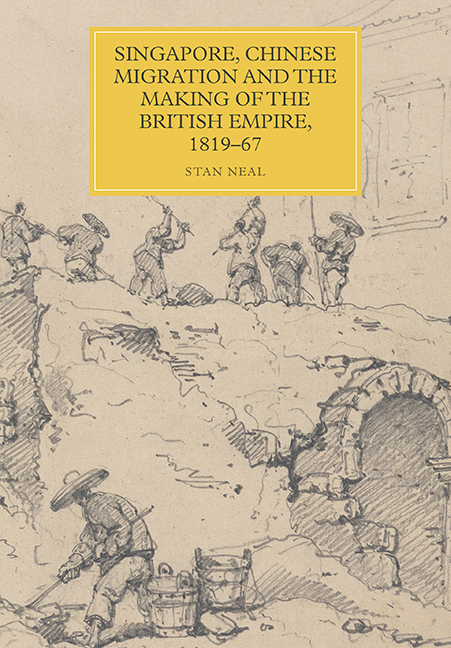Book contents
- Frontmatter
- Dedication
- Contents
- List of Illustrations
- Acknowledgements
- Language Usage
- Chronology: Singapore, the British Empire and Anglo-Chinese Relations, 1819–67
- Map
- Introduction
- Chapter 1 The Singapore Model
- Chapter 2 The Chinese Character: Race, Economics, Colonisation
- Chapter 3 Crossing the Indian Ocean: Chinese Labour in South Asia and Beyond
- Chapter 4 From Singapore to Sydney: Race, Labour and Chinese Migration to Australia
- Chapter 5 Hong Kong versus Singapore: The Dawn of Mass Migration
- Conclusion
- Bibliography
- Index
- Miscellaneous Endmatter
Chapter 2 - The Chinese Character: Race, Economics, Colonisation
Published online by Cambridge University Press: 26 June 2019
- Frontmatter
- Dedication
- Contents
- List of Illustrations
- Acknowledgements
- Language Usage
- Chronology: Singapore, the British Empire and Anglo-Chinese Relations, 1819–67
- Map
- Introduction
- Chapter 1 The Singapore Model
- Chapter 2 The Chinese Character: Race, Economics, Colonisation
- Chapter 3 Crossing the Indian Ocean: Chinese Labour in South Asia and Beyond
- Chapter 4 From Singapore to Sydney: Race, Labour and Chinese Migration to Australia
- Chapter 5 Hong Kong versus Singapore: The Dawn of Mass Migration
- Conclusion
- Bibliography
- Index
- Miscellaneous Endmatter
Summary
‘The Civilized World Versus China’ was how the Canton Register described growing animosity between the Western merchant community and the Canton authorities in 1835. The British opium trading firm Jardine Matheson owned this newspaper and its editorial line reflects the widely accepted decline of Western perceptions of China. The dominant historical narrative has been that a positive view of China, and by extension the Chinese, in the sixteenth and seventeenth centuries had transformed to a negative and critical attitude by the early nineteenth century. The seventeenth and early eighteenth centuries were the height of Western fascination with Chinese institutions, society and culture. The praise of influential thinkers such as Gottfried Leibniz and Voltaire, as well as the fetish for Chinese architecture and Chinese consumer products, are all evidence of European reverence towards the civilised Celestial Empire. In the late eighteenth century a combination of commercial and diplomatic frustration led to a transformation of how people in Britain perceived China more broadly. The failure of the Macartney Embassy (1792–94) was the key moment at which British reverence began to morph into disdain. The formation and circulation of a Western perception of an archetypal Chinese character over the 1830s, in the build-up to the First Opium War (1839–42) between Britain and China, complicates this narrative. As seen in Singapore, colonial observers perceived Chinese migrants as economically valuable, rather than generally positively or negatively. The popularisation of the Singapore model of Chinese migration took place in the wider context of worsening Anglo-Chinese relations.
This chapter will chart the spread and prominence of the idea of a distinctly Chinese racial character through the 1830s and 1840s. This marks a shift from examining the individual agents in the contact zone of Singapore to a broader discussion about the Chinese as a racial category across the British Empire and in Britain itself. Crucially, the wider discussion about China and Chinese migrants in the context of Anglo-Chinese conflict helped formulate images of a simultaneously industrious and duplicitous Chinese character that would prosper under British authority and instruction. British perceptions of a useful Chinese character and Chinese despotism could co-exist once the Chinese population was separated and distinguished from the Qing Empire.
- Type
- Chapter
- Information
- Publisher: Boydell & BrewerPrint publication year: 2019



